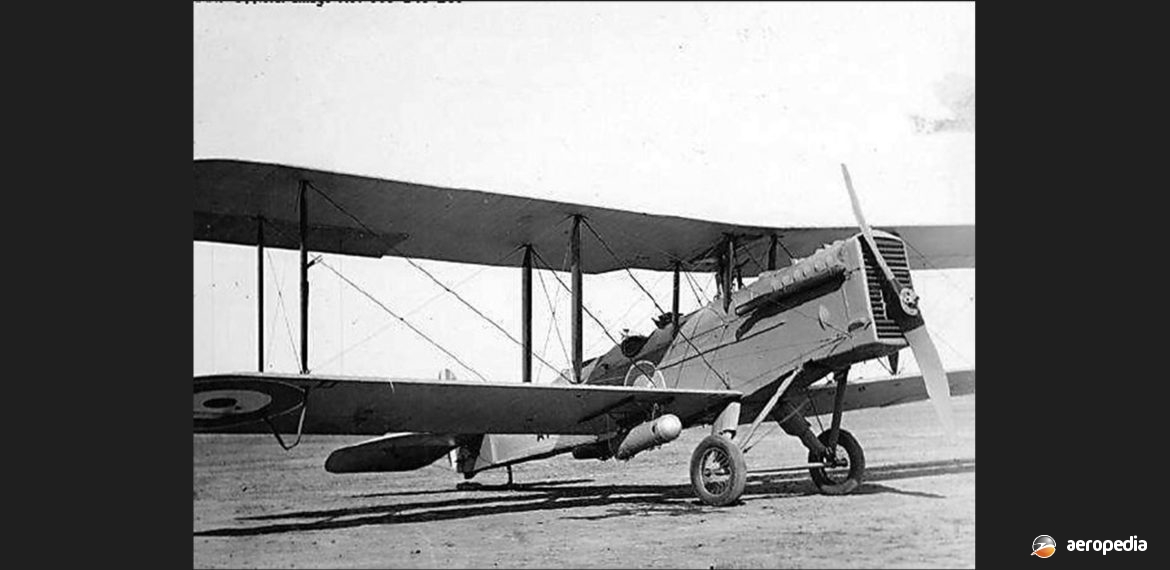Photograph:
de Havilland DH.9A of the RAAF (RAAF Museum)
Country of origin:
United Kingdom
Description:
Strategic day bombing biplane
Power Plant:
One 298 kw (400 hp) Packard Liberty V-1650 27 litre (1,649 cub in) twelve-cylinder VEE liquid-cooled engine
Specifications:
- Wingspan: 14 m (45 ft 10 in)
- Length: 9.23 m (30 ft 3 in)
- Height: 3.47 m (11 ft 4 in)
- Wing area: 45.8 m² (493 sq ft)
- Max speed at sea level: 198 km/h (123 mph)
- Max speed at 4,572 m (15,000 ft): 171 km/h (106 mph)
- Climb to 3,048 m (10,000 ft): 15 mins 35 secs
- Climb to 4,572 m (15,000 ft): 33 mins
- Service ceiling: 5,410 m (17,750 ft)
- Endurance: 5 hours
- Fuel capacity: 509 litres (112 Imp gals)
- Empty weight: 1,337 kg (2,947 lb)
- Military load: 429 kg (945 lb)
- Loaded weight: 2,223 kg (4,900 lb)
Armament:
One 7.7 mm (0.303 in) fixed forward-firing Vickers machine-gun; one 7.7 mm (0.303 in) Lewis machine-gun on Scarff ring in observer’s cockpit; max bomb load 545 kg (1,200 lb)
History:
In 1917 the Packard Motor Company in the US commenced to produce the 298 kw (400 hp) Liberty engine and the DH.9 airframe was modified to take the new engine, becoming the DH.9A. A few de Havilland DH.9s appeared with the 269 kw (360 hp) Rolls Royce Eagle VIII engine, and one was trialled with the 336 kw (450 hp) Napier Lion, the latter being used to set an altitude record of 9,296 m (30,500 ft). The new aircraft had greater power and was mainly different from the DH.9 in having a larger wing area in order to retain the same landing speed due to a heavier all-up weight.
The DH.9A was developed by Westland as de Havilland was at that time putting the DH.10 into production. The DH.9A became known as the “Nineack” in service, the first aircraft being flown in March 1918 and being built of ash and spruce. The prototype (B7664) was first flown with a Rolls Royce Eagle engine but once the Liberty engine became available it was installed. Bomb load was much enhanced, eventually increasing to 545 kg (1,200 lb).
The type entered service in France, the engine in production machines initially providing 295 kw (395 hp) but by May 1918 this had increased to 335 kw (450 hp). The engine became so superior to other units installed at the time that by January 1918 the British Government sought the supply of 3,000 units. However, the DH.9A was a bit late to see much war service, only 288 being completed by the time peace was declared. The type remained in operational service until the 1930s, being involved in skirmishes on the border between India and Afghanistan, and was eventually replaced by the Westland Wapiti.
In 1919, as part of the Imperial Gift of 100 aircraft, the Australian Government was offered 35, and received 30, examples of the DH.9A. The type was built by a number of manufacturers, including Whitehead Aircraft Company, Aircraft Manufacturing Company (Airco), Mann Eagle & Company, F W Berwick & Company, and Westland Aircraft Works. The first aircraft were received in Melbourne, VIC in April 1920 and were operated from Point Cook, VIC. The first four initially carried their RAF serials (E8590, E8616, F2776 and F2779), later becoming A1-26, A1-16 and A1-17, but E8616 was lost on 23 September 1920 when it crashed into Bass Strait and did not receive an A-series serial.
The remainder of the batch received became A1-1 to A1-29, and a further aircraft was obtained to replace the lost machine, this aircraft (c/n 42) becoming A1-30 in July 1923. They were operated in the general purpose role by No 3 Squadron, which was formed with the type at Point Cook in July 1925, and they served until 1929 when they were replaced by the Westland Wapiti.
In 1928 the Sydney Aerial Derby was won by Flying Officer Mulroney in a DH.9A (A1-28) of the RAAF. The aircraft had been modified as a single-seater especially for the event.
Following the disappearance of the Fokker F.VIII/3m ‘Southern Cross’ in 1929 in what became known as the ‘Coffee Royal’ incident, a search was conducted, one of the aircraft involved being the Westland Widgeon VH-UKA ‘Kookaburra’. When it also became lost a search was made for the latter aircraft by a number of aircraft, including DH.9As A1-7, A1-5 and A1-1, the latter being wrecked in a crash near Tennant Creek, NT during the search.
As they were replaced by the Westland Wapiti, the DH.9As were relegated to training duties and, as they became unserviceable, were written off and broken up. None made their way on to the Civil Aircraft Register, and the last recorded use of the type by the RAAF was on 5 March 1930 when A1-14 was flown.
A number were lost in service in accidents, one being on 1 August 1928 when the Supermarine Southamptons of the RAF Far East Flight arrived in Sydney, NSW. On this occasion a number of aircraft were flown to meet the flying boats on their arrival, one DH.9A (A1-25) carrying a press photographer ditching into Sydney Harbour.

